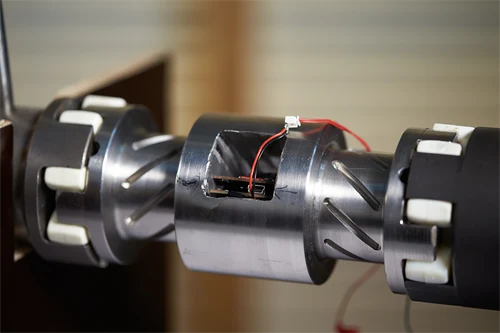TORCI ‑ A robust Torque sensor for Challenging Industrial Applications
Process monitoring of industrial processes is often very limited.
To measure key process parameters the sensors must be able to stand high temperatures and mechanical forces and should not interfere with the process. This project will investigate a method of torque measurement where the deformation experienced by the sensing shaft is converted into volume change.
The sensing principle allows a robust mechanical integration and high temperature operation. To move from principle to an integrated sensing device the following issues must be investigated:
- thermal gradient sensitivity of the sensor element
- sensor miniaturization
- wireless power and signal transfer
The research will be based on theoretical studies with support of FEM modelling and experiments for verification. The project will deliver a torque sensor that outputs sensor information in real-time under real operation conditions of selected industrial application.
Background
Torque measurement can be crucially useful in a variety of current industrial applications for improving product quality and process control. However, in many cases direct torque measurement is not easily achievable due to the limitations of the conventional torque sensors. It is especially true in challenging industrial applications such as, high temperature processes, hazardous environments, applications requiring robustness and reliability. Mid Sweden University has developed a new torque sensor that can provide higher resolution and bandwidth measurements at a lower production and assembly cost than state-of-the-art torque sensors on the market today. Its simple mechanical transducer design is more robust and reliable compared to conventional methods and is more suitable for harsh industrial environments, such as high temperature, and for shafts with high axial and radial loads and high stiffness requirements. In the presented torque sensor design the electronics readout has a soft coupling to the structure which makes it possible to remove it from the sensor. This will enable the use of this method for higher temperatures up to 400oC. Moreover, the transference media: air, which is used in our proposed torque sensor, can be much more reliable than the typical attachment methods used in conventional torque sensors, such as gluing. Hence, we believe the proposed method can address the needs of industry in the aforementioned challenging applications.

Research questions
The sensing principle shows promising results that it can be useful for industrial applications. However, the requirements from the industrial applications increase the problem complexity for the proposed sensing principle.The identified key research questions in this project that need to be addressed, in order to meet these requirements are:
- Can a torque transducer based on our sensing method be designed to fulfil various requirements from industry such as high performance, high operating temperature, miniature size and high torque range?
- Can a fully mechanical torque transducer with remote readout enable the use of this sensing principle in applications where conventional torque sensors cannot be used?
- What is the performance difference of the proposed torque sensor to the state-of-the-art?
Objectives
- Creating accurate and flexible multi-physics model for the optimization of the transducer mechanical design and for the realistic simulation of its response to various environmental influences.
- Better understanding of the practical challenges and requirements from our industrial partners for the potential application of our novel torque sensor. Investigate
- Investigate and optimize our transducer design based on the requirements from both industrial applications and material selection, and manufacturing and assembly processes.
- Investigate the possibility of formulating generalized analytical equation for the torque transducer mechanical design.
- Produce prototype torque sensor based on the optimized design.
- Building the torque sensor experimental setup together with industrial partners both to characterize the performance of the torque sensor prototype and to demonstrate its usability to industry, and also to compare the sensor’s performance with its simulation result in order to verify and improve the quality of the multi-physics model.
Facts
Project period
170301-190228
Partners
- Bucher Emhart Glass
- Röbäcks Sweden AB
